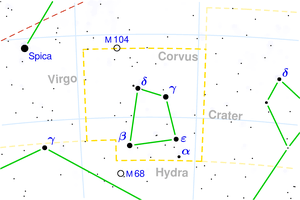|
|
Corvus ( Latin: raven or crow) is a small southern constellation with only 11 stars visible to the naked eye (brighter than magnitude 5.5). It was one of the 48 constellations listed by Ptolemy, who only counted 7 stars.[1] It is among the 88 modern constellations. Notable stars Main article: List of stars in Corvus δ, γ, ε, and β form the 'sail' asterism; and γ and δ serve as pointers toward Spica. Notable deep sky objects Corvus contains no Messier objects. The Ringtail peculiar galaxy consists of the possibly colliding NGC 4038 and NGC 4039, and appears to have a heart shape as seen from Earth. The center of Corvus is home to a Planetary nebula NGC 4361. The nebula itself resembles a small elliptical galaxy, but the magnitude 13 center star gives away its true nature. Mythology In Greek mythology, a raven serves Apollo, and is sent to fetch water from a cow, but it rests lazily on the journey because it sees a fig tree by the pond. The crow waits while the figs ripen and then slowly eats them. He sees a water snake and decides that he can use it as an excuse, and after finally obtaining the water in a cup, takes back the water snake as well. According to the myth, Apollo saw through the fraud, and angrily cast the crow, cup, and snake, into the sky. The origin of this story is likely to be the juxtaposition of this constellation with those of Crater (constellation), and Hydra (constellation), in the area of the sky known as the Sea. Citations 1. ^ This article incorporates content from the 1728 Cyclopaedia, a publication in the public domain. References * Ian Ridpath and Wil Tirion (2007). Stars and Planets Guide, Collins, London. ISBN 978-0007251209. Princeton University Press, Princeton. ISBN 978-0691135564. * Richard Hinckley Allen, Star Names, Their Lore and Legend, New York, Dover. * Thomas Wm. Hamilton, Useful Star Names, Viewlex, Holbrook, NY, 1968. Links
Retrieved from "http://en.wikipedia.org/"
|
|
||||||||||||||||||||||||||||||||||||||||||||||||||||
